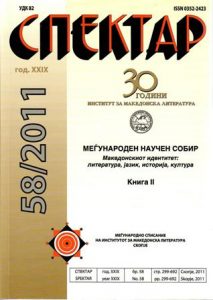ИДЕНТИТЕТОТ НА ПРАВОСЛАВНИТЕ МАКЕДОНЦИ ВО ИСТАНБУЛ
IDENTITY OF ORTHODOX MACEDONIANS IN ISTANBUL
Author(s): Elizabeta KoneskaSubject(s): Politics and religion, Identity of Collectives
Published by: Институт за македонска литература
Keywords: migrations; workers abroad; religion; Slavic belonging; independent church; Exarchate; fluid and multilevel identity
Summary/Abstract: Istanbul for the Slavic’s of the Balkans was an important cultural and educational center. As an economic, political and cultural center of the Ottoman Empire it was an attractive destination for a large number of citizens of different regions. During the 19th century and the first half of the 20th century in the multiethnic and multi religious city of Constantinople or Stambol, as popularly known by the Slavic’s population it was enriched with dwellers from the neighbors of Rumelia, and with population from Macedonia. Today in Istanbul they represent a special ethno –religious group of the Orthodox Slavic community. Having in mind the historic past, as well as the developing processes, this community can be defined into four fluid identification layers: Bulgarian, Macedonian, Christian and Urban. For the identity of this group of citizens possibly represents a conservative state from the period of the formation of the national identity in the wider region, in frames of the historical, political and sociological context. However, this is also the outcome of the changing conditions in which the community continually existed and was influenced by a fluid of a multi leveled identity, in which dominated the religious and urban layer. The cultural processes of which influenced the younger generations of the community, additionally not being familiar with the traditional language had a great enforcement in process of their assimilation in the class.
Journal: Спектар
- Issue Year: 2011
- Issue No: 58
- Page Range: 630-638
- Page Count: 9
- Language: Macedonian

